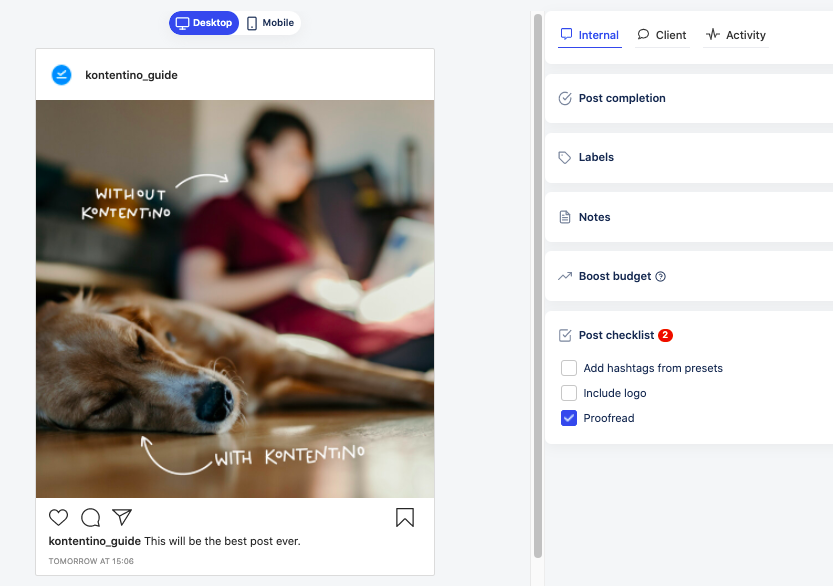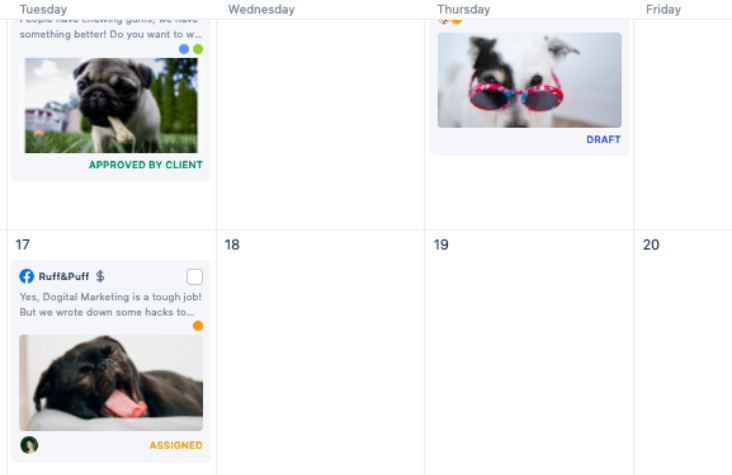Saying that social media agencies have a lot on their plate in 2022 is quite an understatement. If you run a marketing agency and want to stand out from the crowd, then you’re in for a challenge for streamlining social media collaboration.
Finding the golden mean between marketing automation and personalization can be a struggle, but you need to do it in order to stay in the game. Keeping up to date with the latest news is crucial, but it should not overcome a smooth collaboration and approval process within your company.
While adapting to the latest social media trends should be an important part of your strategy, managing processes within your agency can be make or break. If it is all sorted out, it will be like a well-oiled machine.
But if something cracks, creaks and crackles:
Let’s face it: without the right social media collaboration and approval process, you’ll be unable to work effectively, grow your social media agency and serve your clients right.
So, what can you do if it simply does not work just yet?
The role of a social media collaboration and approval process in a marketing agency
The better the social media collaboration plan and approval processes are, the more efficient your work is. Simple as that, and it is the bread and butter of each agency. If you have a lot of team members and clients on board, you know that discussing even the slightest detail can take ages. It doesn’t have to, though.
A seamless social media collaboration and quick approval process can contribute to a more successful marketing strategy. It can also positively impact NPS among your clients, cut operational costs and improve your team satisfaction.
To fully understand the role of collaboration planning, it is a good idea to briefly go through some short descriptions.
The approval process in social media workflow is the process of accepting or rejecting a particular thing connected to social media: a piece of content, a file, a proposal for an ad campaign, for example – just to name a few.
The approval process can happen both internally (team-level) and externally (client-agency level).
Internal social media collaboration is cooperation on a team-level or company-level regarding social media projects and tasks within the organization.
Why is social media collaboration troublesome? Common mistakes
Social media collaboration, as simple as it seems, can cause many problems. We’ve listed some of them below.
Lack of procedures
If you work remotely with your team and your clients but do not sort out procedures, you can find yourself in trouble very often. Setting up even a few simple rules (regarding sending for approval or post requirement checklists) can help you keep your workflow sane.
Being afraid of automation
Marketing automation tools are for social media people to use and ease the pain connected with many everyday, repetitive tasks. Many marketers, though, are a bit hesitant when it comes to using tools. They prefer doing things manually, instead of automating tedious tasks with tools.
Scope creep
Have you ever heard of scope creep? This happens when a pile of tasks grows unintentionally, making the whole project bigger and out of control. Changes contribute to unauthorized growth of the scope of the project and generate nothing but mess. Without procedures, you should expect trouble.
Different expectations
Before taking on a new social media project, make sure that the expectations of both parties are met. If you promised the moon to your client – but do not deliver – then do not be surprised if they are not satisfied with your services, and the collaboration is just tough. If your client is pushy and incredibly demanding even outside of normal working hours, you may say “goodbye” to any thought of effective collaboration.
How to prepare an effective social media collaboration plan in a marketing agency?
Sorting out processes inside the agency can be a game-changer not only when you struggle with workflow, but also if you simply want to improve it. There are a few good collaboration tips you can take into consideration for collaboration planning.
Audit your social media collaboration
Do you think that your social media collaboration works wonders and there is nothing you can change? What about some small improvements? To start applying any quick fixes, you need to identify what doesn’t quite work yet. The same as in the case of a social media audit, you should research it and be on the lookout for possible bottlenecks. There may be quite a few reasons behind a cranky social media collaboration: a lack of response, a slow reaction, no communication, a lack of daily stand-ups or leaky procedures.
Have a clear social media strategy
Everyone in your team should be on the same wavelength and fully understand what brand collaboration is. It takes only one person to demolish a workflow, so if there is anyone in your team who negatively affects it, you should sort this situation out as soon as possible. Setting up a clear social media strategy by highlighting the most crucial rules is not a choice – it is a must here.
Know who is who
Recognizing roles is one of the most important parts of social media collaboration. Everyone in the team should have clear information about who is responsible for what profile, what platform and what tasks – and how all of these individuals can work together for the same outcome: amazing social media communication.
Let’s say that there is a social media team consisting of 4 people:
Sarah, Jonathan, Melanie and Thomas.
As a team leader, Sarah is responsible for communicating with clients and dealing with their requests. It takes a lot of time, so she is not able to create great content ideas herself.
This is what Melanie and Thomas are doing – preparing creative copy for Facebook and Instagram profiles. However, they are still quite new to the team and do not know everything about their clients or tone of voice yet, so they would need a bit of help.
This is where a content manager Jonathan stands up – being a connector between junior content managers and a team leader. Jonathan checks posts for their compliance with the social media strategy and after the first internal approval, he sends it further to Sarah, who in turn sends them on to the clients for approval.
This is just an example of how a social media collaboration process can work.
Create a social media guideline
This should be your go-to document in case of onboarding, hesitating as for the strategy or double-checking whether your social media collaboration goes in the right direction.
Creating a complex social media guideline does not happen overnight. You should also update it from time to time and it should be accessible for everyone involved in a particular social media project.
What should it include? While you can customize it as you want, your brand collaboration guideline should definitely cover the six areas below:
- social media strategy for collaboration plan,
- the tone of voice,
- brand guidelines,
- brand digital assets,
- collaboration procedures (responsible persons, response times, templates),
- (extra) collaboration procedures in the light of a social media crisis.
Master task management for collaboration planning
Not everyone likes getting tasks, and not everyone likes delegating them either. However, this needs to be done and you should not be shy about asking for help and dividing tasks. Everyone should know their position in a social media workflow – while one person is in charge of creating posts or making interactive infographics only, another one can check them grammatically, and yet another person can give the final internal approval before a particular post goes live or for the clients’ approval. Very picky and precise task management, at least at first, can help you avoid many misunderstandings and social media crises.
Use tools
There are tools that do not solve problems – they create needs instead. You don’t need them. What you need is a set of tools that can improve your social media collaboration and make your work a breeze. Don’t be afraid of testing out some tools along with your team and check whether they improve your work quality and collaboration plan or not.
Does it sound a bit terrifying? We bet it does – however, once you start making these small first steps, you’ll see that your social media collaboration starts working.
How to cooperate in the most efficient way with your clients? External communication.
Client-side social media guide
To make a social media collaboration not only successful but also hassle-free, you should create a social media guide for your clients as well. Include important information there about who is in charge of communication on a particular social media profile, what the strategy and tone of voice are, as well as templates for answers and communication plans that you have previously approved with your client. This is something you can come back to.
Onboard your clients and get them involved
It is very important to get your clients involved in creating social media guidelines and sorting out procedures of social media workflow. The more involved they are, the more understanding they will have when it comes to the social media collaboration and approval process.
Show them the benefits and the power of feedback
Sometimes, clients are simply not aware of the powerful magic of feedback. One of the best collaboration tips is to show them, even with just a few bullet points, why their quick and detailed feedback matters and how it can affect social media communication. By showing them a collaboration plan for their marketing, you can make them conscious about its importance and more willing to bring it into life – all together with your team.
Use tools
Yes – tools are not only for social media managers, so do not forget about them when preparing a brand collaboration guide for your clients. There are a few tools that can benefit not only your team.
It goes without saying that social media collaboration is the key to success. Do you know that you can polish it with Kontentino?
With this extra layer of approval and security, you can take care of your social media workflow and collaborate – both internally and externally – in the most efficient way.
Kontentino collaboration tips
Post requirement checklists
These checklists can be really effective for collaboration planning. You can customize checklists for each profile and keep adding your own requirements. This feature can work wonders, especially if you have a new client you are not fully onboarded with yet, or if you have some interns who should learn the rules first. With handy post requirement checklists, they can cross off the respective points when their content meets them, and therefore save a lot of time for whoever is going to approve them internally.

Sending posts for clients’ approval
The creme de la creme. No more messages, e-mails or pigeons with requests for approving some created posts.
You can send your clients a request for approval directly from Kontentino, and they can approve the content with just one click. They can also do this via a mobile app, if and when they are somewhere in Bali sipping long cocktails.
Of course, they can also reject your content and send it back for reworking, leaving you some comments and feedback that you can instantly apply. Just imagine how long it would take to change a single typo over e-mail.
In Kontentino, it takes seconds. The same story goes for internal approval if you want to send it to someone in your team to approve. Handy status fields (below) give you clear info about how you’re doing with your content and whether it is ready to be published.

Translations for international brands
Do you run social media communication for profiles from all over the world, in many languages? You can manage social media collaboration within teams easily, since Kontentino delivers options to translate posts right next to the original version.
Task assignment
You can easily discuss content and share insights with your clients and your team within Kontentino, but you can also delegate tasks to people who are assigned to a particular project. Instead of coming to their desk or sending them an e-mail, you can delegate tasks in Kontentino so that the person who’s responsible for changes gets notified immediately. No more “it went into my SPAM” excuses.
Types of Social Media Collaboration
#1 Agency – Client (Brand) collaboration
When we talk about social media collaboration, this type is probably the first one that comes to mind. It’s the most traditional form of social media collaboration, in which an agency works with a client (brand) to create social media content.
The agency is responsible for the social media strategy, content creation, and execution in this form. The client (brand) provides input on the social media strategy and approves the content before it’s published.
This type of collaboration can work well if both parties are clear about their roles and responsibilities. It can also help to create a more streamlined social media process, since the agency is in charge of turning plans into action.
However, this type of social media collaboration may also create a power dynamic that can be difficult to navigate. For example, the agency might feel like they’re always trying to please the client (brand), which can lead to creative compromise.
If the client (brand) isn’t happy with the content that’s been created, there can be a lot of back-and-forth between the agency and the client (brand) before the content is finally approved. This can be frustrating for both parties and can lead to a lot of wasted time and effort.
Alternatively, the client (brand) might micromanage the social media content. This can be troublesome for the agency.
It’s important to find a social media collaboration model that works well for both parties involved. If not, the process can lead to tension and frustration on both sides.
Good practices for Agency – Client (Brand) collaboration:
- create a centralized content calendar
- set social media goals and objectives
- develop creative briefs for each social media campaign
- have regular check-ins (e.g. weekly or monthly) to review progress
- clearly define roles and responsibilities from the start
- create a system for content approvals
#2 Agency – Agency collaboration
Especially in the case of larger clients or multinational companies, it’s not uncommon for different agencies to work together on social media campaigns. This type of collaboration can be between two separate agencies who are working for the same client, or between a social media agency and another service provider (such as a PR agency).
In either case, social media collaboration between agencies is essential in order to avoid any duplication of effort and to make sure that everyone is working towards the same goal.
The key to successful social media collaboration between agencies is communication. All parties need to be on the same page from the very beginning in order to avoid any confusion further down the line.
Good practices for Agency – Agency collaboration:
- have a centralized campaign calendar and schedule
- set up regular calls or meetings to catch up on progress
- designate one point of contact for each agency
- create social media guidelines
- use a project management tool to keep track of tasks
#3 Agency – Influencer/Brand Ambassador collaboration
Sometimes, social media collaboration isn’t just between an agency and a client (brand). It can also involve working with influencers or brand ambassadors to create social media content. This type of social media collaboration can be extremely effective, as it allows you to tap into their audience and followers.
However, it’s necessary to make sure that the influencer or brand ambassador is a good fit for your brand before you enter into a collaboration. The last thing you want is for them to post content that doesn’t align with your brand’s values or message.
Good practices for Agency – Influencer/Brand Ambassador collaboration:
- research potential influencers and ambassadors
- create social media guidelines for influencers and ambassadors
- set up a system for content approval
- have regular check-ins with influencers and ambassadors
- establish clear goals and objectives from the beginning of the collaboration
With the right collaboration system in place, you’ll be able to not only run influencer marketing campaigns for your clients, but also scale your efforts. This means that you’ll be able to work with more influencers and reach a larger audience than ever before.
#4 Client – Influencer collaboration
Agencies are not required at each and every step of the process. Sometimes, clients (brands) can work directly with influencers to create social media content.
This type of social media collaboration can be beneficial for both parties involved. The client gets to work directly with the influencer, and the influencer is allowed more creative freedom when it comes to posting content.
However, there are two sides to the coin of not involving agencies. On one hand, the client might be able to save money by working directly with an influencer. On the other hand, there’s a risk that the content will not align with the brand’s message or values.
Good practices for Client – Influencer collaboration:
- make sure arrangements are in writing to protect both the brand and the influencer
- double check that there are no conflicts of interest if an influencer is working with multiple brands
- have realistic expectations for what an influencer can deliver
- set clear guidelines for content and messaging if more influencers are involved
- use social media management tools to help with tasks like content approval and tracking analytics
Can all of these social media collaboration types exist simultaneously?
Social media collaboration can take many different forms depending on the needs of the brand or client. The most critical aspects are to ensure that everyone involved is on the same page and that there is clear communication between all parties.
With the right system in place, social media collaborations can be extremely successful. That’s why you may want to take a closer look at all of the capabilities that Kontentino delivers in terms of successful social media collaboration and approval workflow.
Leverage social media collaboration
We could be writing about social media collaboration benefits and collaboration tips for hours.
Get your team together and try to recognize any bottlenecks in your brand collaboration as well as ways of improving it. Then, simply start working on making it better, and use tools to automate some of your tedious tasks and give you some extra features to skyrocket your everyday work.
Even your clients may thank you for doing that.





